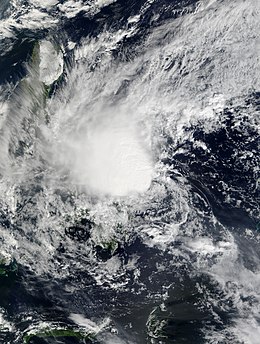Tropical Storm Lingling (2014)
| Tropical storm (JMA scale) | |
|---|---|
| Tropical depression (Saffir–Simpson scale) | |

Tropical Storm Lingling off Mindanao on January 18, 2014
|
|
| Formed | January 15, 2014 |
| Dissipated | January 20, 2014 |
| Highest winds |
10-minute sustained: 65 km/h (40 mph) 1-minute sustained: 55 km/h (35 mph) |
| Lowest pressure | 1002 hPa (mbar); 29.59 inHg |
| Fatalities | 70 deaths |
| Damage | $12.5 million (2014 USD) |
| Areas affected | Philippines |
| Part of the 2014 Pacific typhoon season | |
Tropical Storm Lingling, known in the Philippines as Tropical Depression Agaton, was a weak but deadly tropical cyclone that affected the Philippines in January 2014. The first named storm of the annual typhoon season, this early-season cyclone remained very disorganized throughout its lifespan. Lingling was the first major natural disaster in the Philippines after Typhoon Haiyan in 2013, as it caused widespread landslide incidents and floods in Mindanao, resulting in 70 deaths and damage amounting to over 566 million pesos on the island.
The predecessor of Lingling formed as a tropical depression southeast of Mindanao on January 10, yet it weakened into a low-pressure area on January 12. After crossing the island on January 13, the system redeveloped into a tropical depression off the northeast coast of Mindanao on January 15. After drifting generally westward and consolidating slowly, the depression intensified into Tropical Storm Lingling on January 18. Without further improvements, Lingling weakened into a tropical depression on January 20 because of its sheared structure and diminishing convection.
On January 10, the JMA reported that a tropical depression had developed, about 1,800 km (1,120 mi) to the southeast of Manila, Philippines. The JMA expected the system to develop into a tropical storm within 24 hours, despite it being located in an area of marginal conditions for further development. Under moderate vertical wind shear, the system became highly sheared on the next day, although strong northeasterly trade wind surges and a good westward outflow enhanced by the strong easterly upper-level winds were helping to sustain the associated convection. On January 12, the JMA no longer expected a tropical storm and even downgraded the tropical depression to a low-pressure area late on the same day, when convection became more disorganized.
...
Wikipedia
